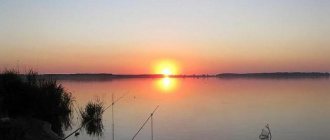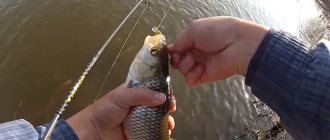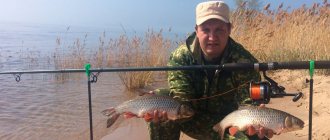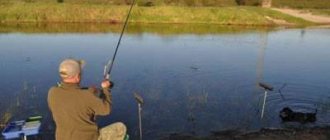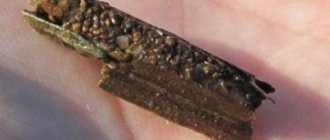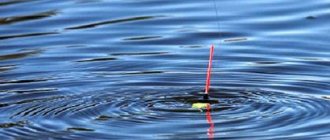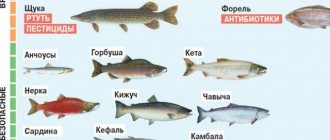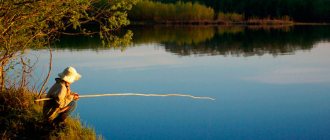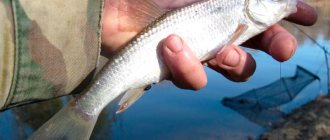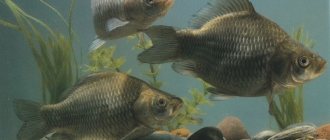River lamprey larva as bait
There are some baits that are considered rare. They are not as popular baits as worms or maggots, but in terms of their catchability they can seriously compete with them. Such baits are also called wild baits.
It is difficult to obtain such baits due to their scarcity or the difficulty of obtaining large quantities. Lamprey larva is considered one of the most effective wild baits.
River lamprey larva is an excellent bait
They are often called sand sanders. They are an excellent bait for catching fish. It can move on the hook for a long time, thereby attracting many fish. They are extremely difficult to obtain, but doable, and they lead a very modest lifestyle.
You can catch pike perch and even pike with a lamprey larva. The chub loves this bait very much. If you use it, then prey will be found every hour, guaranteed. You can throw such bait with bottom tackle in the evening, and in the morning you will get a pleasant surprise - a fairly large chub.
The sandfish really has some kind of magical powers, because it can lure a chub out of any hiding place. And if there is at least one individual of this fish in the fishing place, then it will definitely be caught.
Many fishermen consider the minnow an unattainable luxury, because it is very difficult to find, despite the fact that lampreys are found in many bodies of water. It is difficult to find due to the fact that the appearance of the sand miner is very unremarkable, and it hides well at the bottom of the reservoir or in thickets.
It has many names, it all depends on its habitat. For example, it is called eel, gander, loach, minnow, spindle. But, this is not a fish, but just its larva, which will eventually grow into a full-fledged lamprey. The gerbil has no scales or bones.
Its length reaches only 2-3 cm, and it has not yet developed gills. It lives in almost all clean freshwater bodies of water with a good current. In most rivers it can be found, only in small quantities.
The development of the larvae into a full-fledged fish takes several years. She loves sandy or muddy bottoms. You need to look in creeks or where there is a lot of algae growing on the sandy bottom. If you need to look for larger individuals, then they live on the rifts.
The most difficult thing is not the search, but the extraction. To do this, you need to remove the top layer of soil and very quickly move it to the shore. And after that they look for larvae in the soil. They are incredibly slippery and agile, making them difficult to catch. Sensing danger, they burrow into the ground or hide in the water.
What kind of fish can you catch with this bait?
This bait is mainly used for catching large fish that like to hunt in riffles. You can catch a lamprey larva:
Over 13 years of active fishing, I have found many ways to improve the bite. And here are the most effective:
- Bite activator. Attracts fish in cold and warm water with the help of pheromones included in the composition and stimulates its appetite. It’s a pity that Rosprirodnadzor wants to impose a ban on its sale.
- More sensitive gear. Read the relevant manuals for a specific type of gear on the pages of my website.
- Pheromone-based lures.
You can get the rest of the secrets of successful fishing for free by reading my other materials on the site.
- Chub
- Bream
- Guster
- Yazya
- Soma
- Pike-perch
- Perch
Finding and catching lamprey larvae
In order to find a sand drill you need to find a suitable place. They can be overgrown or silted areas in a reservoir, as well as creeks where there is a slight current. The depth in the place is not particularly important; the most important thing is the presence of a good layer of silt, about half a meter deep. It’s easy to feel the depth of the silt; you just need to go into the water and feel how deep your feet go.
But even if there is a suitable area with a sufficient amount of sludge, this does not mean that larvae will be found in it. Sometimes you have to probe a lot of areas before luck smiles.
To find it, you need to scoop up a layer of silt and pour it onto the shore, after which you should very carefully scan the turned-up silt in search of the desired bait. Checking with your hands is most effective, because you can feel the movement. Place the spoils in a bucket with a small amount of water and algae.
When you are sure that there is the desired prey on the site, you need to scoop up the silt with more suitable equipment. You can make a ladle with a long handle, which is turned towards the person. Using such a bucket will greatly speed up the digging process, and there will be no need to go deep into the water. This is very convenient, especially when the weather is cold and you don’t want to freeze. You need to pull the soil ashore very quickly so that the prey does not have time to escape.
If even several attempts in different places do not give results, then you can try to dig deeper. After all, there is a possibility that the lamprey sensed danger and hid deeper. Sometimes it can be found in the soil layer under fallen leaves or near the roots of plants.
Storing lamprey larvae
When fishing, they can be stored in a container with a small amount of water, but you need to monitor its temperature, because they can die in warm water. If it’s a hot day outside, then you should change the water often and put the container in a cool place.
At home they can be stored in a dark and cool place; if the storage temperature is approximately 16 degrees, the larvae can last for about two weeks. It is better to store it in a glass jar into which you pour a little water. You can add soil taken from a pond to the container, then the sand grinder will be buried in it and can live even for a month.
Fishing with lamprey larva
Smaller specimens are used for fishing with a float rod, and larger specimens are used for bottom tackle. It is better to lower such bait to the very bottom; it will not be able to bury itself in the silt, because the hook will hold it tightly. It will wriggle and raise a cloud of dust, which will interest many fish, especially predators.
When it starts to bite, there is no need to rush to pull it out, the fish may break loose. You need to wait a little until the fish has completely swallowed the bait, and only then hook it. In this way, the prey will hook itself. The equipment must be tugged periodically to prevent the sand drill from burrowing and hiding at the bottom.
Place on the hook
This larva is very slippery, so it is very difficult not only to pull them out of the mud, but also to put them on a hook. Smaller specimens are placed on a single hook. The point is passed through the mouth opening and removed through the abdomen. Large larvae should be put on a tee so that they do not fall off.
In this case, one or two of the hooks are put on the back, clinging to strong skin, and the other is threaded into the mouth and out through the abdomen. To prevent the bait from slipping and running away, it is fixed with pieces of rubber, which are placed on the points of the hooks.
Reviews from fishermen
This kind of bait is used quite rarely, but those fishermen who have tried fishing with a sand drill are very pleased with the result.
Having caught 271 kg of fish, the poachers were not punished!
During interrogation, the detained fishermen revealed the name of the secret bait.
Read more…
that the lamprey larva is an excellent bait, I use it to catch predators. It's just a little difficult to catch. I tried using a mesh shovel, when you pull out the soil and immediately wash it, then only pebbles and larvae remain in the bucket.
Grade:
bolshoyulov.ru
LRIO.RU
Lamprey belongs to the group of lower jawless vertebrates, which in its reproduction goes through the larval stage. The lamprey larva is also called sandworm. The lifespan of the larvae is 4-5 years.
The larva has a rounded body, light brown in color, slightly lighter closer to the abdomen. It grows up to 20 cm in length. However, it is better not to use such giants as a whole bait. The average size of the larvae used by fishermen usually does not exceed 10-12 cm.
The sand miner can be caught in reservoirs with clean running water and a sandy bottom, where it likes to settle near the shore covered with vegetation, in backwaters and creeks, where it looks for food in the bottom silt or in the coastal sand. You should know that the lamprey larva is very active and quickly flees, hiding in the underwater ground.
Traditionally, searching for and catching larvae is difficult and is carried out at depths of no more than 1 meter by scooping up bottom silt with a shovel or bucket, quickly throwing it ashore and then washing it.
The bait should be stored in a container with the water in which it was caught, making sure to provide ventilation in the lid and changing the water daily. The container should not be allowed to overheat, as this can cause rapid death of the larvae. Often, bottom silt is placed at the bottom of the container, making sure that it does not dry out, but is not too wet.
For longer storage of larvae, you can place them in the freezer. Naturally, the quality of the nozzle decreases.
The lamprey larva can be used as a fishing bait during the ice-free season. It is noted that in spring and summer, catfish, pike, chub, ide, perch and pike perch readily take it. Quite large bream and silver bream will not refuse it. In autumn, the larva is one of the most attractive baits when catching predatory fish.
Usually mobile on a hook, the larva, when fishing from the bottom, trying to hide in the bottom soil, raises mud from the bottom, which attracts the attention of feeding fish.
The lamprey larva should be placed on a hook by piercing one of the breathing holes located near the head and replacing the gills, and removing the sting through the mouth or another breathing hole.
There is a practice of impaling by penetrating the body of the larva in the area of the back, approximately 1.5-2 cm from the head, and also by impaling it by the lip. When using a tackle with several leashes, it is quite possible to bait one larva onto two hooks, which is done by piercing near the head and in the tail.
The attachment is suitable for fishing with float or bottom tackle, and when hunting for predators, also with various kinds of casting tackle, mugs, girders, etc. Fishing with bottom gear requires checking it a little more often than usual, since a bait buried in the bottom is more difficult to detect by fish.
In such cases, experienced fishermen practice a slight tightening of the fishing line, which is done once every 30-40 minutes, or they place the larva on small tees by piercing it through the mouth.
How to catch a lamprey?
Lamprey has a delicious taste and is a real delicacy that was valued back in Ancient Rome.
The appearance of the lamprey is in many ways reminiscent of the loach, but this fish has a thinner body, there are no paired fins, and the body is without scales. Several species of lamprey live in our freshwater bodies. After the larvae emerge from the eggs, this fish can remain in the larval state for about 5 years. The length of the larvae can be 20 cm.
In addition to its gastronomic qualities, this fish is highly valued by fishermen, as is its excellent bait. The larvae of this fish are excellent for this purpose; they are very mobile and resilient, attracting many predatory fish. You can get larvae in the places where they live.
Lamprey in the larval state prefers to live in places with sandy and muddy bottoms of rivers and streams. The larva makes horizontal passages in the bottom formation. Typically, for life, the lamprey larva chooses places where there is wood debris, bays and creeks with a weak current. Lamprey is usually absent from swampy and stagnant bodies of water.
How to get a lamprey larva? This is a fairly simple method; for this you will need an ordinary iron bucket, a shovel or a wide metal ladle. Next, use a bucket or other object to scoop up a certain amount of muddy soil. Pour it onto a flat surface of the bank and level it out. Soon the larvae will reveal themselves with their quick, characteristic movements. And here you can no longer hesitate, the larva can instantly slip out of your hands and very quickly burrow right into the shore.
You can catch larvae using another method. To do this, you need 2 pieces of turf of approximately the same size, and attach them with the earthen part to each other. Then you need to make holes in these pieces of turf with a thin stick or wire. This lamprey larval trap should then be placed on some kind of mesh frame and immersed in water in the lamprey larval habitat. After 2-3 days, you can check the trap; larvae will probably be living in it. Other organisms, dragonfly larvae, leeches, and water worms can also live there. All of them, like larvae, can serve as excellent bait.
Storing lamprey larvae is not difficult; they can be kept in any container, as long as the water temperature is not too high. The lamprey larva is very sensitive to increased water temperature and this can lead to the death of the larvae. If the weather is hot, the water in the container where lamprey larvae are stored should be changed more often. Lamprey larvae can be stored in a cool, dark place for about 2 weeks, at a temperature no higher than 15-17 degrees. Glass or aluminum containers are best suited for storing larvae. The dishes should not be filled with water to the very top. The optimal amount of water should not exceed a distance from the bottom of 12-15 cm.
Fishing with lamprey larva
Typically, small lamprey larvae are used as bait on float gear, and medium and large larvae are excellent bait for bottom gear. Small and medium-sized larvae, as a rule, are placed on single hooks, through the mouth and removed through the abdomen. As for large larvae, they should be placed on doubles behind the back of the larvae, or on two hooks, with one hook hooked behind the back and the second in the mouth with the outlet in the front of the abdomen. For greater reliability, to hold the wriggling larva on the hook, you can fix the removed hooks with small pieces of rubber.
When fishing, the lamprey should be kept at the very bottom; the larva will not be able to burrow into the mud, since the hooks will hold it. Lamprey larvae are loved by pike, perch, asp, ide, chub and pike perch. There is no need to rush when biting. You should let the predator swallow the larva and only then hook it. It often happens that when a predatory fish bites, it detects itself.
Lamprey fishing
It is almost impossible to catch lamprey with ordinary fishing gear. But there are other ways to catch it. This fish is mainly caught using a variety of traps. One of these methods is catching by light during spawning. So, powerful electric lights are placed along the riverbed, and traps are pre-placed in spawning areas. The lanterns are placed in such a way that only a small passage remains, through which the lamprey falls directly into the set traps.
Lampreys are also caught with beetroot (muzzles). Such fishing is carried out even on an industrial scale. Burak is a tackle in the form of a mesh cone with metal or plastic rings from 70 cm to 80 cm long. In the wide part of the muzzle there is a funnel, which is plugged with a stopper. The snouts are placed on a long rope, the distance between the traps is about 70 cm. Then the structure is lowered to the bottom of the river in those places where the lamprey lives throughout the night. Encountering such traps on its way, the lamprey enters them, and there is no way back for it. On average, about 50 lampreys fall into one beetroot per night.
Lampreys are also caught using loach traps. This method is usually used by fishermen on the Onega River. These traps look like a barrel made of splinters.
These splinters are fastened in 3 places using ropes and a hoop made of metal or plastic is put on top. On one side of such a trap, the bottom is made closed, and on the other, a special funnel also made of splinters is inserted. These traps are placed in those parts of the river where there are stones and placed in one row.
You can also catch this fish using hems; they are usually installed in such a way that they fit tightly to one another. They are then attached to pins. These are special structures made of stakes that partially block the river in those sections of the river along which lamprey migrates.
The main places for catching lamprey are the Lower Volga, Neva, Kura, Onega, Narva. In rivers such as Onega, Neva and Narva, all lamprey caught is marinated on an industrial scale. Narva pickled lamprey is especially famous. This is a truly delicious delicacy.
fishers.spb.ru
Lamprey of the Arkhangelsk region. How to catch it and make fish soup from it
Irina Orlova | January 24, 2021
In this article I will talk about the lamprey and its biology. Also, after reading my article, you will learn about how lamprey was caught in tsarist times - and how it is caught in our time, how and why experienced fishermen use lamprey meat, and, of course, how to prepare a delicious fish soup from it. Now make yourself comfortable, I'll get started.
The idea for this article came about by accident. I suddenly realized that lamprey is the same object of catch as fish, and these two classes have one thing in common: they live in the reservoirs of the Arkhangelsk region. The activity and life cycle of fisheries in the region depends on weather and natural conditions. Natural conditions also affect the behavior of lampreys. It rises to spawn from August to February along the rivers Northern Dvina, Mezen, Onega, and Vaga.
It is not difficult to identify migrating spawning lampreys: the river in which they spawn is inhabited in summer by sandworms and lamprey larvae. There are known cases of lamprey being caught in the Pinega River, although lamprey fishing has never been developed here. During spawning migration, the lamprey does not feed, since it is busy feeding intensively at the end of summer, parasitizing on the body of fish, absorbing their blood and muscle mass. It rises to spawn in the dark, in the absence of moonlight, and the rest of the time, also during the day, it clings to the stones and stands against the current or hides in secluded places until favorable daily conditions occur.
After spawning, the adult dies, and the larvae live in fresh water for many years, feeding on aquatic microscopic organisms. They filter the water, thereby obtaining food for themselves. Then they roll into the sea and, having fed the eggs, rise to their hatching sites for reproduction and subsequent death.
Lamprey was the object of mass fishing at the beginning of the twentieth century. The catch was carried out with ryuzhe traps and minnows (or loaches, as they are called on Onega). The caught specimens were pickled, smoked and preserved. The finished product was sold even outside the region. Currently, the lamprey fishery, as well as its recreational fishing, is practically forgotten, but interested people can obtain a fishing permit: three traps per person.
This permit can be used by the indigenous inhabitants of the area where this type of fishing is possible. The state is allowed to catch individuals with a body length of at least thirty centimeters. But any “loach” that goes to spawn is considered sexually mature, and we already know what happens to it after reproduction. The body length of a mature individual depends on the quality of food: the better the lamprey was fed, the longer and heavier it will be.
I myself saw how on Onega lampreys are caught with loaches, which have the shape of a truncated cone, the diameter of the upper part of which is 30 cm, and the bottom - 60 cm. These loaches are made up of 120-centimeter long wooden planks. The planks are fastened together in three places with wire, then three more metal hoops or thick wire rings are stuffed onto them. A neck (in other words, a yatynets, or funnel) 40 cm long and also made of strips fastened together with wire is inserted into the lower end of the cone.
The base of this throat is attached to the very mouth of the barrel; the narrow hole has a diameter of no more than 10 cm. The narrowest part of the trap is used to extract prey. It is tightly closed with two semicircular boards of different sizes. A wooden rectangular handle is attached to the small semicircle, which, in turn, is tied with ropes to the large semicircle for reliability.
Our lamprey fishing begins in mid-August and continues until mid-February. Usually, loaches are placed in groups of three along the shore, mainly near stones and in gaps between large stones. With successful fishing, such a number of lampreys fall into the loachfish that one person is not able to remove it from the water, which, however, is determined by the small number of fishermen who are keen on this method of fishing.
Installation of traps is carried out at any air temperature, during a thaw and even in forty-degree frost, this makes this type of fishing very labor-intensive and dangerous. To set a trap correctly, the fisherman prepares the place in advance by hollowing out the ice in winter and removing interfering stones during the warm, ice-free period. In winter, some sections of the river are not covered with ice due to the fast current, partly facilitating the installation of loaches.
The caught lamprey is used for bait, cut into small pieces and placed on donkey hooks. You can catch burbot and any other predator from the shore in this way. For this method of fishing, I recommend using sharp and extendable hooks, then when caught on a stone or snag, the catch and the tackle itself can be unhooked.
Catching a predator with a donk largely depends on weather conditions: during the full moon, burbot hides in cover, which reduces the likelihood of being caught. But other predators, such as brown trout, may also covet the lamprey bait. Sometimes a predatory fish swallows a baited hook so deeply that it cannot be removed without a special tool. For such cases, I always carry a forceps and scissors-clamp with me.
The advantage of bottom fishing is that, having cast the tackle, you can leave it alone and catch it with a float. The disadvantages of this fishing method include the moment you throw the sinker into the water - it makes a splash. This can frighten and drive out large fish hiding at the bottom or nearby.
The structure of this tackle is quite simple: the bottom part of the fishing rod consists of a sinker, two hooks and a carabiner, all of this is attached to a main leash about a meter long so that the carabiner and sinker are attached to its different ends. We tie the hooks onto separate 25-centimeter leashes, then attach the free ends of these leashes to the main leash so that when the gear is positioned vertically, the upper hook is several centimeters higher than the attachment of the lower hook, and the lower hook does not touch the sinker. I recommend using cord as a material for production; it is much stronger than monofilament fishing line, so it is more preferable when fishing for large fish.
The choice of sinker for the tackle depends on the nature and speed of the water flow in the fishing area, as well as on the characteristics of the bottom topography in the reservoir - in fast flows it is better to use flat and heavy sinkers, and when fishing in calm water with a difficult bottom, you can use elongated sinkers - “Tyrolean sticks." The latter were invented for salmon fishing in the fast, rocky mountain rivers of Austria. I use these sinkers for one reason - due to the reduction in the number of snags on stones and snags, but in a fast current the “Tyrolean stick” is carried away.
Bottom fishing in winter is more successful because... in summer, fish eat insects flying above the surface of the water and small multicellular organisms living in the aquatic environment. In winter, a hungry predator is limited in its choice of food items, which increases the chances of its capture.
The specificity of catching burbot is that it searches for prey in shallow water, mainly at night. Therefore, you can come to the intended territory of his hunting (as a rule, this is a backwater with a fast current), throw a bottom with pieces of lamprey attached, secure the opposite end of the bottom “braid” on land and leave it overnight, and check it in the morning. The second way to catch burbot with lamprey in the dark is with the help of a fishing rod: we come to a pond, throw the tackle into the water. We wait for the bite, sometimes twitching the tackle to create vibrations in the water column.
Fishing for trout is carried out in fast currents, because Brown trout feed in river rapids, but can also drop in where the water is calmer. We cast the tackle from the fishing rod and wait for a bite. Don’t forget to control the tackle so that it doesn’t get carried away by the current or hit the rocks.
The bait for catching predatory fish in winter is adult lampreys, which are caught during their migration to spawn. To preserve the bait, the lamprey is cleaned, washed and frozen, and if necessary, taken out of the freezer, then cut into small pieces. The bait made from pieces of lamprey must be placed on the hooks so that the sting sticks out slightly from the flesh, but the barb of the hook remains hidden and cannot prick the fish that comes up behind the bait.
I also note that fishermen actively use sandworm larvae to catch large predatory fish in the summer, baiting them on the hook of a donkey or a float rod. They look for them in a muddy bank with grass, digging up the bottom with a garden fork or shovel. The lamprey is widely used in sea fishing. It is used as bait for catching navaga and smelt.
The main connoisseurs of lamprey are the Baltic countries. They can find loach in any supermarket smoked, fried and in jelly. In Russia, lamprey is valued in the regions where it is caught, where delicious loaches (lamrey pies) and hearty fish soup are prepared from it. The recipe that I will now share existed before I was born, but is still popular today in families of fishermen and connoisseurs of lamprey dishes as a valuable food product.
Let's get started! For a family of four, you need a two-liter saucepan, 600 g of raw lamprey, three medium or two large potatoes, table salt, black peppercorns and a bay leaf.
We clean the lamprey by cutting off the head and making an incision a centimeter from the anus to remove the entrails. Then we remove the intestine through the incision of the head. After this, cut the fish into pieces, about one and a half centimeters apart.
Wash the peeled and cut into pieces lamprey thoroughly with cold water 2-3 times in a basin or colander under running water. It is necessary to rinse until the water becomes clear. Place the washed lamprey in boiling water and cook for 30 minutes. During cooking, do not forget to scoop out any fat and foam that appears on the surface of the cooked dish.
After half an hour, throw the potatoes, salt and black pepper into the saucepan. We continue to cook the dish, checking the potatoes for doneness. Don't forget to descale. When the potatoes are ready, taste the lamprey. It should not crunch on the teeth, but be soft and tender. The final touch is to throw a bay leaf into the pan with the fish soup, washed, of course.
The soup is ready! I recommend eating it with bread and onions. Bon appetit!
Lamprey fishing
Despite the fact that in appearance the lamprey hardly resembles a fish, but is more similar to a huge worm or snake, it is still a fish. Moreover, this is not a simple fish, but a fish is a parasite that feeds on the blood of other fish, as well as their muscles. Having a suction cup-shaped mouth, it sticks to the body of a large fish and bites through it with countless teeth. The lamprey secretion contains an enzyme that prevents blood clotting, which subsequently leads to the death of large fish. Any category of fish can become victims of lamprey, but sturgeon, cod and salmon species suffer the most. Sometimes she sticks to the whale. This fish poses a certain danger, therefore, it should only be taken from below the head. If a lamprey bites, the wound will take a long time to heal.
This fish is one of the oldest representatives of the fish species. It inhabited water bodies 360 million years ago and has been well preserved in its original form to this day. There are currently more than 30 species of lamprey. Most of these species are freshwater lamprey. Despite this, sea lamprey spawns in freshwater rivers. The fry of this fish are sandworm larvae, which bear little resemblance to their parents, therefore, they were previously classified as a separate type of fish.
Description of lamprey
The lamprey should immediately be classified as a unique creature, so the story about it will differ from the traditional description of the fish. The lamprey has a snake-like, scaleless body on which classic fins cannot be found. The mouth of this fish resembles that of a leech, and the single nasal opening is located in front of the eyes. The gills consist of 14 openings, in the depths of which specific gill formations can be observed. This structure of the gills makes this fish unique as water enters and exits through the gills, unlike other varieties of fish where water enters through the gills and is expelled after being filtered through the mouth. But the most interesting thing is that it lacks ribs and bones, and the spine consists of an ordinary chord, like many sturgeons, but it is not so developed. The lamprey's head is made up of cartilage only.
Where does the lamprey live?
This fish is found in almost most bodies of water on our planet. It is divided into three main subspecies: river, brook and sea lamprey. In Russia you can find 2 subspecies: river and brook lamprey. The river subspecies of lamprey is capable of breeding not only in rivers, but also in lakes and seas, therefore, they are found somewhat more often than the brook subspecies. In Russia, it is caught in the Baltic Sea basin (Neva River), as well as on the Volga. Naturally, it is found in all small rivers flowing into large rivers. In Russia it is considered a delicacy, compared to America, where it is not eaten at all.
When does lamprey spawn?
Lamprey, like most other fish species, spawns in late May and early June. In this case, it all depends on the region. The warmer the area, the earlier it leaves for spawning. Lamprey takes the process of spawning much more seriously than other types of fish. That's why it has survived to this day. Such places where this fish lays eggs are called nests. The male builds this nest, spending all his skill on it. He clears the place of third-party objects and even stones, which he has difficulty moving from the place he likes. To do this, he uses his suction cup mouth, and with his tail he forms a depression. After preparing the nest, the male retires with the female, where they lay eggs, after which the female and male die. Therefore, lampreys lay eggs only once in their lives.
How to catch lamprey
This is a fish that is impossible to catch with traditional bait, so they resort to certain devices and traps, such as nets. It’s not bad to catch lamprey with your hands, especially before spawning. Alternatively, you can adapt the loach fish or use more advanced and advanced technology for catching it. To do this, waterproof lamps are used, which are lowered into the water on one side and the other of the channel, illuminating it, but at the same time leaving a narrow space where the trap is installed. The lamprey cannot stand light and tries to slip into this corridor, where it falls into a trap.
Catching lamprey with your hands - video
Igor 02/19/2017
fishingday.org
